 Safe
Water System Manual
Safe
Water System Manual

7.0
Plan strategy for changing behavior

Tasks:
A
Safe Water System project must:
•
present to the target population a compelling reason to try the Safe Water System
•
create a demand for the products
•
change the behaviors of the community to include use of the Safe Water System.
The
Safe Water System requires ongoing use to be effective. Initially, there may be
good participation in terms of purchasing a container and a bottle of disinfectant.
However, for the system to have a health impact, households must purchase and
properly use the disinfectant on an ongoing basis.
Success
depends on the degree to which the intended target households can be convinced
to change their behavior, specifically to:
•
acquire the products (vessel and disinfectant)
•
try using the Safe Water System, and use it correctly
•
use it consistently over time.
Traditional
practices of water storage and use may be difficult to change for many reasons:
•
Families may not consider the problem of diarrheal diseases as serious as other
diseases like fever or measles and may not be motivated to use a product designed
for preventing diarrheal diseases.
•
Because diarrheal diseases are seasonal, the perception of risk may vary by season.
(This was seen in Zambia, where sales peaked during the rainy season and dropped
in the dry season.)
•
Safe Water System products may seem costly.
•
The new behaviors may seem inconvenient.
Behavior
change is complex. There are different theories and strategies for bringing about
a behavior change in a population that have been used with varying success. Behavior
change is always the result of a combination of factors. Changing the behavior
of a community in a lasting way is slow and can be difficult.
Health
education alone is not sufficient to bring about behavior change23,
but it can be an important contributor by raising awareness of waterborne diseases
and how to prevent them. Promotion, using social marketing techniques, can also
be an important influence to purchase and use a product.24 Motivational
interviewing can greatly increase effectiveness as this type of communication
helps to bring about and support internally-motivated change in people.25
Community mobilization has great potential for inducing behavior change because
the community defines its problems and the programs it wants. This creates a powerful
demand even before the project is implemented.11
Safe
Water System projects have used health education, community mobilization, social
marketing and motivational interviewing. Of these methods, health education, when
used alone, has proven to be least effective, but it remains an important supplementary
element to each of the other approaches. Experience has shown that if implemented
well, each of these methods can have a significant influence on the behaviors
of purchasing and using disinfectant solution correctly and storing water safely.
What
is Education or IEC (Information, Education, and Communication)?
Educational activities
aim to increase knowledge in the target population. When planning the educational
component of a project, sometimes people use the term IEC, which stands for information,
education and communication, to indicate that a broader range of activity is envisioned
than just traditional classroom instruction or a health worker telling a group
of mothers what they should do.
In
a Safe Water System project, educational activities:
•
are usually implemented through interpersonal communication with health workers
or sellers of the products, print materials distributed in health centers or outlets,
street theater, and video presentations.
•
generate awareness of the problem of diarrheal diseases, the severity and particular
risk to young children, and the link with contaminated water. 
• provide
information about preventing diarrhea by disinfection and safe storage of water.
• teach
households how to use the vessel and disinfectant solution, and inform people
where to obtain the products.
•
are best planned using results of formative research on the target population's
knowledge, attitude and practice.
See
Annex E for some example educational materials. Although educational activities
are necessary to provide a knowledge base about the problem and practical solutions,
they have not been shown to be effective when used alone. The manner and methods
that are used to convey educational information can be extremely influential in
laying a foundation for people to choose behavior change. When individuals decide
on their own to change, it is much more likely to endure. Motivational interviewing
(see below) is a potent communication strategy that can enhance IEC activities
and promote the initiation and maintenance of behavior change.
It
is important to coordinate IEC activities with other activities that are already
being conducted by other agencies. IEC messages should be consistent with educational
messages of other agencies to avoid confusion in the target population. If other
agencies are delivering inaccurate messages that will conflict with Safe Water
System messages, then tactful efforts should be made to correct erroneous messages.
What
is Promotion? Why is it Needed?
Since
information alone is seldom enough to change behavior, it is advisable to employ
other approaches to increase the possibilities that people will try and will continue
Safe Water System behaviors. Behavior change can be increased when promotional
activities supplement educational activities.
Promotional
activities:
•
aim to stimulate individuals to sample new products and behaviors and to
continue using those products.
•
use messages specifically formulated to encourage the target population and deliver
those messages through channels that will be effective with the population.
•
are based on research on the population and reasons for their behaviors. (See
explanation of principles of social marketing in section 6.1).
• motivate
potential users to buy the products and assist them in using the products correctly
and consistently. This requires more than giving factual information about diarrhea,
water disinfection and storage.
Promotional
methods used in social marketing persuade people to use products for reasons that
are tangential to the main reasons for the implementation of the project. For
example, the main reason for a Safe Water System project is to prevent diarrhea.
Social marketing may imply however, that women who use the Safe Water System are
better mothers, trend setters, or smarter. Marketing research can determine how
best to appeal to potential consumers.
Educational
activities are an important partner to promotion because they provide the knowledge
needed to understand promotional messages. Education can help to facilitate behavior
change by giving people the knowledge to understand the problem, find and purchase
the products, and use the products correctly, once they decide to do so. Both
promotional and IEC messages can appear on the same materials, such as brochures
and posters.
What
is Motivational Interviewing?
Motivational
interviewing involves an interpersonal communication method that is grounded in
health behavior theories, decision-making theory and motivational psychology.25
It
is very useful to enhance IEC, promotional activities and community mobilization
efforts. The empirical evidence supports motivational interviewing. It is effective
in different cultures in producing internally-motivated changes in a range of
health behaviors. However, training in motivational interviewing requires a person
experienced in the method. In Zambia, it was used successfully to strengthen
the initiation and sustained use of the Safe Water System.13
Motivational
interviewing incorporates the theoretical model of the stages of change, which
conceptualizes change as a process that people move through at different levels
of readiness.26 The stages are:
•
Precontemplation: The person is not ready to consider change or is unaware
of any need to change.
•
Contemplation: The person is ambivalent, both considering change and rejecting
it.
•
Preparation: The person is open to changing and may be preparing to make
a change.
•
Action: The person is actually engaging in actions with the intention of
bringing about change.
Offering advice or suggestions for taking action to a person who is not ready
for change can be premature, inappropriate, and ineffective. A more person-centered,
stage-based approach such as motivational interviewing has been shown to be more
powerful in bringing about sustained changes in behavior.
Motivational
interviewing is effective in moving people through the stages of change and towards
initiating health-promoting behaviors. The method of motivational interviewing
involves:
•
listening carefully
•
reflecting back certain themes that the person talks about,
•
eventually eliciting a person's own reasons for change, and
•
helping the person define the personal resources that are the most relevant to
accomplish that change.
One
of the goals is to create awareness in the person of their behavior and how it
may be at odds with their desired goals. Motivation for change comes from within
the person and can be a result of this discrepancy. It is emphasized that responsibility
to initiate the change, as well as to maintain it, lies with the person. Another
goal is to support an individual's self-confidence that he can succeed in his
change efforts. So, while there are certain strategies and tools involved, the
defining feature of motivational interviewing is a style of communicating in a
partnership rather than in an expert role.
In
Zambia, the Safe Water System project successfully trained community members
from a wide range of experience and educational levels (including community health
promotion volunteers, health professionals, and social scientists) to do motivational
interviewing. Training involved didactic instruction, role-plays, exercises, and
practice.27 Following the training, it was important to devote time
to supervision, guidance and encouragement in the field. See Annex F for more
information about training staff in motivational interviewing.
What
is Community Mobilization?
Community
mobilization is a process by which the community defines their own problems, decides
which are higher priority, and organizes itself to address the priority problems.
In
Madagascar, CARE used this method in its Household Livelihood Security Program
(MAHAVITA) to help communities form a community organizational structure to diagnose
and analyze problems as described below:
Stage
1: Eligible communities were selected as potential participants in the project.
Community leaders were informed about Programme MAHAVITA. If the community decided
to participate, their leaders signed a memorandum of understanding with MAHAVITA
personnel outlining their collaboration.
Stage
2: The community was mobilized to identify community facilitators and form
a project committee (`Structure de Development'). The facilitators received special
training from CARE teams with special skills in communication or social work.
The committee then identified resources available to them such as resource persons,
influential individuals, local community organizations, and outside organizations.
All community members were informed of the committee and its activities.
Stage 3:
The committee facilitators led the members through a participatory needs assessment
and problem analysis of the current situation of the community. The committee
studied the history, geography, demographics, existing structures, and socio-economic
activities of the community. They identified principal problems faced by the community,
including problems faced by different sectors of the community. They then analyzed
the causes and effects of the problems.
Stage
4: The committee transformed the results of the problem analysis into a community
development plan. The committee and community members began planning strategies
and exploring possible interventions by analyzing opportunities that existed for
the community (such as NGOs working in the community or available government programs).
They determined goals, objectives, activities for projects, and indicators to
measure progress.
Stage
5: The committee approached potential partners, such as service providers
and NGOs, with their community development plan. Contributions included donated
time, funding, technical assistance or services. As resources were acquired, implementation
of projects began.
Programme
MAHAVITA personnel assisted neighborhoods with each stage of this process to increase
the likelihood of success and incorporated the Safe Water System into the process.
The Safe Water System intervention helped to accelerate community participation,
boosted confidence in the process, and provided an economic incentive (that is,
income generated through sales of Safe Water System products). The success of
this project led CARE to expand it to other regions of Madagascar. By working
through this process with some success, communities achieved a sense of empowerment
that stimulated the community to continue efforts to improve its condition.
Steps
in Developing a Strategy for Behavior Change
Regardless
of the methods that will be used in the strategy for behavior change, there are
some general principles and steps that are involved in planning all of them. Those
steps are:
•
Conducting formative research (in addition to research described in section
1.0). This is the foundation for selecting methods and
for planning every aspect of each method.
Formative research is most effectively done by people with experience in doing
such research, so the research group should be selected with care. Formative research
will serve as a baseline by which results can be measured, so monitoring and evaluation
activities must be coordinated with formative research (see section 11.0).
•
Identifying the specific target population for the behavior change.
• Planning
positioning (that is, product identification, brand name, logo, etc).
• Planning
key messages. These are the key messages to convey, regardless of how messages
will be conveyed.
•
Selecting methods for behavior change and communication channels. These
are methods that the project will use to affect the behavior of the community.
Possible methods might include education, promotion, social marketing, motivational
interviewing and community mobilization. If a marketing approach will be used,
selection of a marketing consultant or advertising agency is an important part
of this process.
Communication channels are specific ways that behavior change methods are implemented.
Possible channels include, for example, posters, radio spots, house-to-house visitors,
community meetings, labels on disinfectant bottles, local drama.
•
Specifying communication materials needed. These are the exact materials
needed to implement the methods planned. They include advertising and promotional
materials, educational materials, training for implementers, video, radio spots,
etc. Both promotional and IEC messages can appear on the same materials.
The strategy for
education and promotion in your project will depend on the level of funding, staff,
method of distribution and other resources available. The extent of effort devoted
to research and design will vary depending on resources and the size of the target
population.
If
a project has a generous budget and qualified staff, a substantial effort may
be made to implement promotional activities, train staff to deliver education
and incorporate motivational interviewing in interpersonal interactions, and support
ongoing implementation of educational activities. If the project's budget or other
resources are very limited, educational activities might be limited to a smaller
target population and facilities used regularly by that population, such as health
centers and outlets that sell the products. Promotional activities might be limited
to only a few community activities. Perhaps the most attractive feature of community
mobilization is that it can be accomplished with a small budget.
In
any case, all the planning steps described in this section are done to some
extent, in coordination with the plans for production and distribution.
 7.1
Conduct formative research
7.1
Conduct formative research
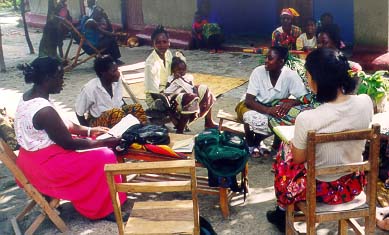 Conduct
formative research in order to develop an effective strategy for behavior change.
Earlier assessment (described in section 1.0) should have
identified gaps in people's knowledge about diarrhea and safe water practices
that need to be addressed by educational activities. Further research on cultural
and language issues, and knowledge and beliefs about diarrhea and water, will
enable the project to develop a meaningful product brand and effective promotional
messages. The priorities of the community members and their ways of getting projects
done will determine much about how the project will be undertaken.
Conduct
formative research in order to develop an effective strategy for behavior change.
Earlier assessment (described in section 1.0) should have
identified gaps in people's knowledge about diarrhea and safe water practices
that need to be addressed by educational activities. Further research on cultural
and language issues, and knowledge and beliefs about diarrhea and water, will
enable the project to develop a meaningful product brand and effective promotional
messages. The priorities of the community members and their ways of getting projects
done will determine much about how the project will be undertaken.
Behavior change
methods to motivate households to change can be only as good as the information
they are based on. Formative research seeks to:
•
find out from people themselves what will motivate behavior change
•
find out what advantages people see in adopting new practices
•
identify obstacles that need to be overcome
•
find out who in the household makes decisions about purchasing household products
and water treatment and storage and who influences those decisions
•
identify media channels that reach specific audiences
Some
information on current practices was gathered in the assessment in Step 1.0;
depending on the completeness of that information for the target population, more
or less investigation may be needed. Specific information needed is listed in
Figure 8.
Annex
G lists some possible methods of research and provides some examples of formative
research tools. Local authorities can characterize a town's social institutions,
subgroups and occupations. Other research methods include:
•
survey of knowledge, attitudes and practices as regards water in the home and
the link with diseases
•
focus groups
•
cohort studies for disease problems
•
structured observations
•
structured interviews
 Figure
8: Formative Research Needs for Planning for Behavior Change
Figure
8: Formative Research Needs for Planning for Behavior Change
Knowledge
and attitudes toward the desired behaviors: -
What do people know about safe water storage and disinfection? -
Why do people practice or not practice certain behaviors (obtaining Safe Water
System storage container; keeping stored water safe from contamination by hands,
animals; regularly cleaning water storage container; purchasing disinfectant,
etc.)? -
What behaviors might need to be addressed by a promotional campaign? -
Are special water vessels affordable? -
Is ongoing use of disinfectant solution affordable? -
What previous experience do people have with water disinfection products? With
other water treatment practices, such as boiling? -
Are any subgroups currently using disinfectant or special water storage vessels?
Why do they do this? Why do other subgroups not do this? -
What are peoples' attitudes toward treating water with disinfectant? -
In what ways are the recommended water storage and disinfection practices inconvenient
or difficult for households to carry out?
Responsibility
for water in the household and related purchases: -
Who decides about making household purchases? -
What kinds of purchases do different household members make? -
Who controls the household budget? -
Who takes care of water in the home? -
Who takes responsibility for water treatment? -
Who influences the household decisions about purchases? -
Who influences the person with responsibility for water treatment?
Incentives and
barriers: -
What are existing knowledge and perceptions about diarrhea? -
What positive perceptions does the population have about using Safe Water System
vessel and disinfectant solution? -
What are the barriers to use of the Safe Water System? _ cost of vessels, cost
of disinfectant solution, difficulty obtaining vessel or disinfectant, seasonality
of income, negative attitudes toward disinfectant (e.g., dislike of taste of chlorine,
distrust of treatment of water)? -
What is important to individual (rank, acceptance, being a good mother, etc.)?
Channels
of communication: -
What channels reach each specific audience? (Channels can include media and opinion
leaders that you want to influence) -
Which of these channels are credible for this sort of message? What are the costs
to use each listed channel?
|
 7.2
Identify specific target audiences
7.2
Identify specific target audiences
 Based
on findings of formative research, identify particular subgroups (e.g., mothers
of small children) that will be target audiences for behavior change. Also identify
individuals who influence that target group (e.g., community leaders and opinion
leaders) so that they may also be targeted with education and promotion. These
main groups in the community should be targeted by different methods through different
communication channels.
Based
on findings of formative research, identify particular subgroups (e.g., mothers
of small children) that will be target audiences for behavior change. Also identify
individuals who influence that target group (e.g., community leaders and opinion
leaders) so that they may also be targeted with education and promotion. These
main groups in the community should be targeted by different methods through different
communication channels.
Specific
target groups overlap and may include:
•
individuals who make decisions about household purchases and about water storage
and treatment
•
mothers of young children and other household members who have influence over
mothers, in order to decrease diarrhea rates in young children
•
specific groups, individuals or opinion leaders in a community who, after becoming
informed, then decide to change their own behaviors. This, in turn, can influence
behavior change in the community as a whole.28
•
groups not typically targeted, such as men, who may divert family resources to
other uses
 7.3
Plan positioning (e.g., brand name product with logo to appeal to mothers)
7.3
Plan positioning (e.g., brand name product with logo to appeal to mothers)
To "position"
the Safe Water System means to present it in a way that will motivate potential
users to buy the products and use them (that is, change specific behaviors related
to water disinfection and storage.) An effective approach to positioning includes
developing a brand name, logo and packaging graphics for the vessel and disinfectant.
This is strongly recommended regardless of the other methods and extent of promotion
planned. Potential advantages include:
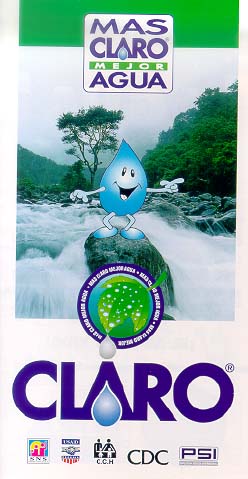 •
Brand names are highly desirable to help create a unique identity for the products
and project. A brand name improves product identification in the target population.
•
Brand names are highly desirable to help create a unique identity for the products
and project. A brand name improves product identification in the target population.
• Branding
can increase the perception of quality and value, create a positive and desirable
image, and encourage people to try the product. In projects in Bolivia, Zambia,
and Madagascar, having a branded hypochlorite solution specifically
promoted for water disinfection helped avoid the problem of bleach being identified
by potential users as a product used for other purposes, like whitening clothes
or cleaning toilets.
•
Although information, education and communication can provide people with information
about the benefits of safe water, advertising a specific brand prompts them to
translate this knowledge into behavior change.
•
Advertising a particular brand of vessel or disinfectant helps to promote safe
water vessels and disinfectant in general. Experience with other products such
as condoms suggests that promoting one brand has a "halo effect", boosting
sales of all types of condoms. In Zambia, a commercial bleach manufacturer
began advertising its brand as a water purification product in response to PSI's
successful social marketing campaign to promote Clorin.
•
Experience shows there is a high demand for subsidized products and that demand
decreases as prices increase. Promoting branded products may help to maintain
demand at higher prices. (Consider this in planning for cost recovery; see section
8.0.)
 7.4
Plan key messages
7.4
Plan key messages

Messages
should address a few feasible and relevant target practices or behaviors that
will be the objectives of the behavior change strategy. For example:
•
Buy a vessel
•
Buy disinfectant
•
Add appropriate amount of disinfectant to each container of
water
•
If water is turbid, use a cloth filter and/or a settling technique to clarify
water before treating
•
Replace disinfectant when it is gone
•
Use the vessel correctly to store water and protect it from contamination
•
Do not put or let anyone put hands or other utensils into water
•
Clean the vessel periodically
•
Use safe water to wash hands, wash produce, and clean cooking utensils
Messages should
address important knowledge that initial assessment and formative research found
lacking in specific target audiences. For example:
•
The risk of diarrhea for young children; the link between contaminated water and
diarrhea
•
The possibility of preventing diarrhea by disinfection and safe storage of water
(the Safe Water System)
•
Information about how to obtain and use the Safe Water System vessel and disinfectant
solution
•
Where to purchase an approved water vessel and disinfectant solution
•
Price of the water vessel and disinfectant
Advertising
messages highlight qualities desired by target population. For example:
•
Be a super mom
•
Be the first in your neighborhood to use the Safe Water System
•
Smart mothers use the Safe Water System
•
For healthier, beautiful children, use Safe Water System
The target population
includes households with low income and they will have limited ability to pay
for vessels and disinfectant. The project will try to keep the price of these
products low by subsidy and other schemes to lower costs. However one of the goals
of education and promotion will be to make the Safe Water System a priority household
expenditure.
 7.5
Select methods for behavior change and specify communication channels
7.5
Select methods for behavior change and specify communication channels
Based
on formative research and decisions about target audiences, positioning, and key
messages, select several methods to try to change the identified behaviors. Methods
might be education, promotion, motivational interviewing and community mobilization.
Multiple methods are more effective than one. Methods should be sustainable and
expandable.
Also
use information from formative research to select an appropriate mix of communication
channels to reach each specific audience. For example, reach mothers of young
children through interpersonal communication with health workers, brochures for
distribution at health centers and points of purchase for disinfectant, and through
video trucks at markets.
•
Education could be implemented through channels such as school teachers, health
professionals, and dramas at market days.
•
Promotion could be implemented through channels such as posters and brochures
at outlets where disinfectant is sold, face-to-face communication with health
workers, and video trucks at markets.
•
Motivational interviewing could be implemented by community health promoters making
house-to-house visits or by health workers interacting with mothers of young children.
• For
community mobilization, the key communication channel is the neighborhood committee
or its equivalent.
Potential
channels can be categorized as either interpersonal communication, local media,
mass media, and printed materials. Annex H describes
each of these categories and reviews advantages and disadvantages of each.
Choose communication
channels that are:
•
available to the target group
•
appropriate for the target group
•
acceptable
•
cost-effective
Using
a mix of channels to reach each audience is always more effective. Education and
promotion are most effective when delivered through a combination of channels,
particularly printed materials along with face-to-face communication to explain
the materials. Printed materials can be taken home and viewed repeatedly. During
interpersonal communication, individuals can ask questions, get reassurance, etc.
It is
important to have educational and promotional materials at points of sale. Educational
materials must clearly describe how to use the products. Staff and materials at
health clinics should actively promote the Safe Water System and its benefits.
Depending on resources, the project may choose to use additional channels, such
as house-to-house visits by a neighborhood health committee member or a door-to-door
sales person.
For
effective interpersonal communications, choose persons who will be credible to
the target audience and will have the time to carry out the interactions well.
Effectiveness of communication can be greatly increased if staff are trained to
communicate messages, use printed materials, and ensure that messages are understood.
See Annex I for an example curriculum for training staff who will teach households
about diarrhea, use of a disinfectant ("Clorin"), and safe storage of
water. Improving the effectiveness of interpersonal communication is the area
where motivational interviewing has its greatest impact. If motivational interviewing
is selected as a method, the implementers (people having interpersonal contact
with consumers) will need to be trained in the particular skills of motivational
interviewing. (See Annex F.)
 7.6
Specify communication materials needed (e.g., label with dosing instructions)
7.6
Specify communication materials needed (e.g., label with dosing instructions)
When
target audiences, positioning, key messages, channels, plans for distribution
of the products and cost recovery have been determined, you can make a specific
list of materials that will be needed. These materials could include items such
as:
•
label on disinfectant bottle and on water storage vessel (See Figure
9 for guidelines for these labels.)
•
training and reference materials for interpersonal communications (for example,
for health staff who do health education in the health center, and for neighborhood
health committee members who employ a motivational interviewing style when making
house-to-house visits.)
•
posters for display at health centers, schools
•
instructional brochures to distribute to consumers who purchase the products
•
point-of-purchase materials to display at sales outlets, such as posters and counter
displays
•
reference materials for interpersonal communication by sales persons at outlets
(such as frequently-asked questions with good responses)
•
promotional items with logo, such as t-shirts, drinking glasses
•
video on how to use the Safe Water System and its benefits to be shown by a projection
truck
•
script for radio spot
•
support materials for drama group
•
materials for use at community meetings

 Figure
9: Package Labels
Figure
9: Package Labels
The
label on a water storage vessel should include instructions for: •
proper filling •
disinfecting •
keeping water safe (such as not putting hands or dipper into the vessel) •
periodic cleaning of the vessel interior •
suggested applications of treated water, including drinking, hand washing, cleaning
utensils and washing produce
The
label on the bottle of disinfectant solution should include: •
identification of contents •
instructions for measuring the correct amount for the vessel •
shelf life (when to throw away unused disinfectant solution and get more) •
how to keep disinfectant safe, out of the sun, out of the reach of children
|
Below
are some examples of educational and promotional channels and materials that have
been used in different projects. Annex E includes some example materials.

Point-of-purchase
information: Signs, stickers, and place cards are used to identify
outlets and agents where water vessels and disinfectant solution are sold. If
products have a brand name, the brand name is promoted on these materials. Brochures
or leaflets and counter cards provide simple instructions on how to use the products.
Sales persons in shops or health workers in health centers use these materials
to help teach families how to use the products. Posters promote the Safe Water
System with simple messages about the importance for preventing disease.
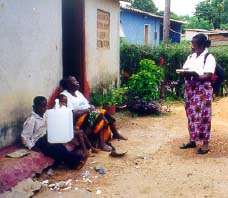 Peer
educators: Educators are recruited through neighborhood health committees,
or already established community health workers are trained to do household or
small group education on the Safe Water System. Peer educators can provide educational
information much more effectively if they are trained in skills of motivational
interviewing.
Peer
educators: Educators are recruited through neighborhood health committees,
or already established community health workers are trained to do household or
small group education on the Safe Water System. Peer educators can provide educational
information much more effectively if they are trained in skills of motivational
interviewing.
Small
group activities: These are presentations at health centers, churches,
schools or other appropriate community forums, organized by neighborhood health
committees and conducted regularly.
Interpersonal:
Health workers at health centers and clinics educate potential users and support
the Safe Water System. Sales persons at stores and house-to-house visitors educate
potential users as part of their sales efforts. These individuals can also be
trained in motivational interviewing to increase the effectiveness of their communications.
 Schools
program: Seminars are held to teach teachers about diarrheal diseases
and home water treatment and to encourage them to include this information in
their curriculum. Presentations are then held in schools to educate students and
their parents. Teachers keep Safe Water System vessels in their classrooms. Day
to day children take turns adding disinfectant and they all enjoy a supply of
safe drinking water at school. When children learn how to disinfect water and
keep it safe, they can help their families do the same at home.
Schools
program: Seminars are held to teach teachers about diarrheal diseases
and home water treatment and to encourage them to include this information in
their curriculum. Presentations are then held in schools to educate students and
their parents. Teachers keep Safe Water System vessels in their classrooms. Day
to day children take turns adding disinfectant and they all enjoy a supply of
safe drinking water at school. When children learn how to disinfect water and
keep it safe, they can help their families do the same at home.
 Promotional
materials: If products are branded (that is, identified with a brand name
as part of a social marketing project or commercial distribution system), branded
items such as drinking glasses, cups, t-shirts, stickers and pens may be used
to promote awareness of the Safe Water System vessels and disinfectant solution.
Promotional
materials: If products are branded (that is, identified with a brand name
as part of a social marketing project or commercial distribution system), branded
items such as drinking glasses, cups, t-shirts, stickers and pens may be used
to promote awareness of the Safe Water System vessels and disinfectant solution.
Mobile
video unit: This is a vehicle that is equipped to show video on a large
screen. It travels from place to place to be seen by potential users in different
neighborhoods, at schools, markets, festivals, and other public gathering places.
Video is most effective when it is accompanied by an educational/promotional presentation
and interaction with an audience.
 Special
events and local media: Clean water fairs are staged at critical times
of the year, such as at the beginning of the diarrhea or cholera season. Sales
agents and health workers make presentations and sell vessels and disinfectant
solution. Songs, dance, drama, and contests make these a major event for the community
and draw large crowds. Local performers deliver essential messages through drama
and jingles. Quizzes and competitions involving the crowd reinforce messages.
Special
events and local media: Clean water fairs are staged at critical times
of the year, such as at the beginning of the diarrhea or cholera season. Sales
agents and health workers make presentations and sell vessels and disinfectant
solution. Songs, dance, drama, and contests make these a major event for the community
and draw large crowds. Local performers deliver essential messages through drama
and jingles. Quizzes and competitions involving the crowd reinforce messages.
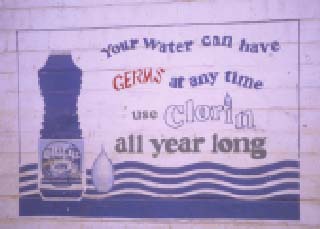 Small
media and outdoor advertising: Posters, billboards, brochures and leaflets
are used to promote the benefits of using the Safe Water System. These materials
should use low-literacy pictorial images and be written in local languages. Local
radio, TV or print media (such as newspapers) are used if they are accessible
to households in the project area. (Note that problems of supply and credibility
are created if mass media advertise the products in a wider area than they are
available.)
Small
media and outdoor advertising: Posters, billboards, brochures and leaflets
are used to promote the benefits of using the Safe Water System. These materials
should use low-literacy pictorial images and be written in local languages. Local
radio, TV or print media (such as newspapers) are used if they are accessible
to households in the project area. (Note that problems of supply and credibility
are created if mass media advertise the products in a wider area than they are
available.)
In
Zambia, the Clorin project was launched with a public event in which local
children performed Safe Water System skits and local dignitaries made speeches.
Local print and broadcast media covered the event. Subsequently, Clorin signs
were painted on walls outside of health clinics. Brochures were distributed at
local events and points of sale. Peer educators developed humorous water safety
skits that were performed in markets and at other public gatherings. Community
health workers were trained to educate their neighbors about causes and prevention
of diarrhea and correct use of Clorin. Clorin
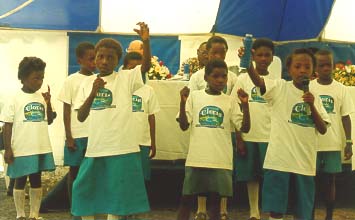 T-shirts
were given away at public events. A video was produced and taken around the country
in mobile video units to show to different communities. Clorin billboards were
painted in strategic locations.
T-shirts
were given away at public events. A video was produced and taken around the country
in mobile video units to show to different communities. Clorin billboards were
painted in strategic locations.
